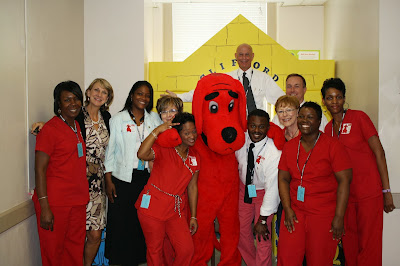 |
Dr. Bernard Eichold speaks with reporters after a news conference Monday
Sept. 30, 2013, on the state of health in Mobile County. The agency's new logo
can be seen behind the health officer in the third floor media room.
|
MOBILE, Alabama -- Health Officer Dr. Bernard Eichold, who leads the Mobile County Health Department, said Monday that agency leaders are renewing their commitment to serve the public by promoting, improving and protecting the health of those who live in coastal Alabama. Eichold unveiled a new logo on Monday, Sept. 30, 2013 to serve as a visible reminder that the 495-employee strong agency takes its mission seriously.
Eichold also addressed the state of health in Mobile County during a news conference Monday, talking about how residents ranked alongside their counterparts in Alabama and beyond on several key health and quality of life indicators.
The idea is that by making people more aware of how certain risky behaviors -- such as overindulging in highly processed foods and sugary sodas, not wearing a seatbelt or engaging in unprotected sex – negatively affect their overall health, they can be encouraged to take positive steps to improve quality of life issues.
Here are some of the topics he talked about:
Causes of death -- In Mobile County, heart disease is the leading cause of death, with a rate of 237.1 per 100,000 people dying from the disorder annually, health statistics show. In Alabama, the rate is slightly higher with 251.8 per 100,000. Cancer is the second leading cause of death in Mobile County, with 226.2 people dying per 100,000 annually. The rate for all of Alabama is a bit lower with 212.5 people per 100,000 dying from causes related to cancer.
Obesity -- The obesity prevalence in Mobile County is slightly lower than that of the state, but significantly higher than the national average. Health statistics indicate that 30.6 percent of Mobile residents are obese, while 31.6 percent of Alabama residents fall into the same category. Statistics show that about 25 percent of Americans as a whole are considered to be obese.
Diabetes – Alabama is one of six states in the nation where more than 10 percent of the population has been diagnosed with the disease, health records show. In Mobile, it’s estimated that about 11 percent of residents, or more than 40,000 people, have been diagnosed with diabetes.
Public safety -- Crimes rates also reflect on the quality of life in a community. The overall homicide rate in Mobile County has been considerably higher than the overall rate for the state, with 12 people per 100,000 dying because of homicides in recent years. The state rate, crime records show, has been 8.2 per 100,000.
Teen Pregnancy – The teen pregnancy rate among 15- to 17-year-olds in Mobile County is alarming, standing at 30.6 per 1,000 live births. Alabama’s teen pregnancy rate is 22 per 1,000 live births, health records show. Teen pregnancies are often at higher risks for pregnancy-induced hypertension and poor birth outcomes such as premature birth and low birth weight. Low birth weight is a major predictor of mortality and disability in infancy and childhood.
Not surprisingly, other health-related indicators in Mobile County and Alabama also soar past national numbers, including rates of premature death, poor mental health days and motor vehicle crash death rates, as reported in community health surveys and U.S. Census Bureau data.
While those numbers paint a grim picture, Dr. Eichold sees hope for our community. He issued a call to action Monday, urging residents to start taking steps to become healthier. He also asked that community leaders come together to create more jogging paths and walking trails within Mobile County. He also contends that any bridge constructed across Mobile Bay should include space for people to walk, run and bike. “If we build it,” he said, “they will come.”
 MOBILE, Ala. -- U.S. President Barack Obama signed a proclamation last week to draw attention to the enormous amount of people suffering from diabetes as he proclaimed November as National Diabetes Awareness Month. With more than 25 million Americans living with a diabetes diagnosis, and
many more going undiagnosed, diabetes affects people across our country and
remains a pressing national health concern.
MOBILE, Ala. -- U.S. President Barack Obama signed a proclamation last week to draw attention to the enormous amount of people suffering from diabetes as he proclaimed November as National Diabetes Awareness Month. With more than 25 million Americans living with a diabetes diagnosis, and
many more going undiagnosed, diabetes affects people across our country and
remains a pressing national health concern. 




















